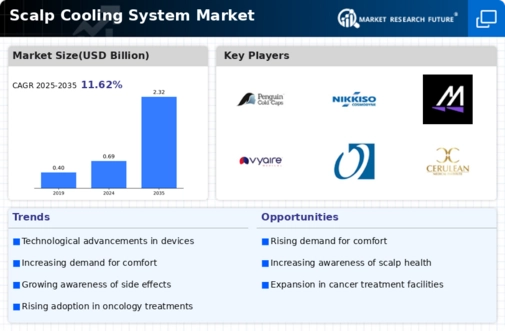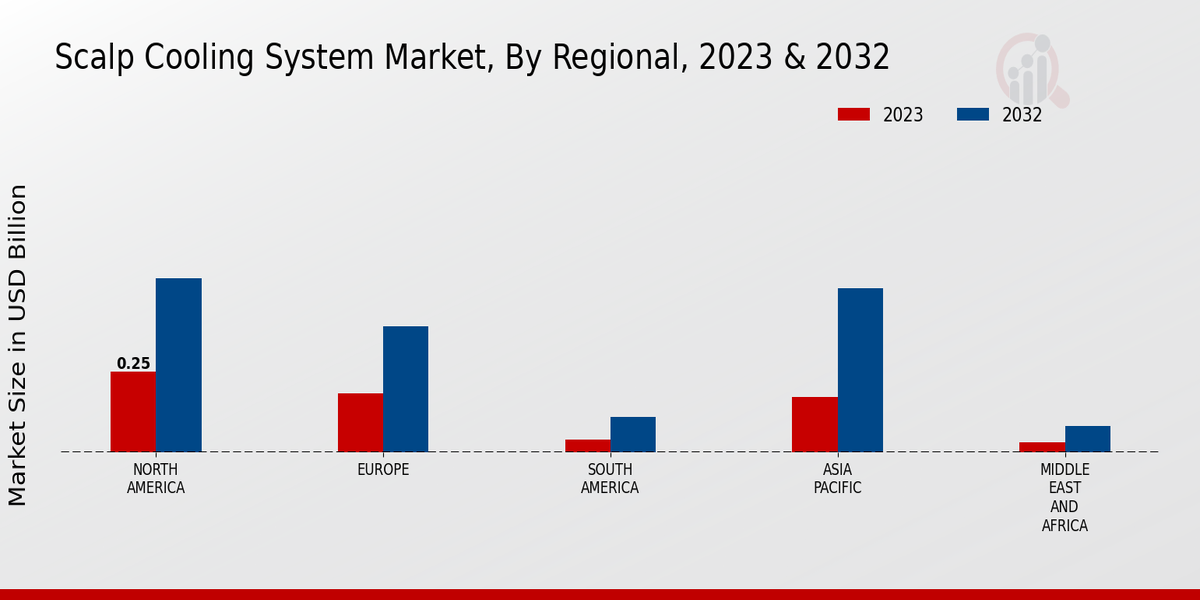Market Growth Projections
The Global Scalp Cooling System Market Industry is projected to experience substantial growth over the next decade. With a market valuation of 0.69 USD Billion in 2024, it is anticipated to reach 2.32 USD Billion by 2035, indicating a robust CAGR of 11.61% from 2025 to 2035. This growth trajectory reflects increasing demand driven by factors such as rising cancer incidence, technological advancements, and greater awareness among patients and healthcare providers. The market's expansion is likely to be supported by ongoing research and development efforts aimed at enhancing the effectiveness and accessibility of scalp cooling systems.
Technological Advancements
Technological innovations in scalp cooling systems are enhancing their effectiveness and user experience, thereby driving growth in the Global Scalp Cooling System Market Industry. Recent advancements include improved cooling technologies that provide more consistent temperature control and user-friendly designs that enhance patient comfort. These innovations not only increase the efficacy of scalp cooling but also expand their application in various treatment settings. As a result, healthcare providers are more likely to adopt these systems, leading to a projected market growth from 0.69 USD Billion in 2024 to an estimated 2.32 USD Billion by 2035, with a CAGR of 11.61% from 2025 to 2035.
Increasing Cancer Incidence
The rising incidence of cancer globally is a primary driver for the Global Scalp Cooling System Market Industry. As chemotherapy remains a common treatment, many patients experience hair loss, prompting a demand for scalp cooling systems. In 2024, the market is valued at approximately 0.69 USD Billion, reflecting the growing awareness and acceptance of these systems among patients and healthcare providers. The increasing focus on improving the quality of life for cancer patients further fuels this demand, as scalp cooling systems can significantly reduce chemotherapy-induced alopecia. This trend is expected to continue, contributing to the market's expansion.
Growing Awareness and Acceptance
There is a notable increase in awareness and acceptance of scalp cooling systems among patients and healthcare professionals, which is a significant driver for the Global Scalp Cooling System Market Industry. Educational initiatives and advocacy from cancer support organizations have played a crucial role in informing patients about the benefits of scalp cooling. This growing awareness not only encourages more patients to inquire about these systems but also influences oncologists to recommend them as part of treatment plans. Consequently, the market is poised for growth, as more patients seek options to mitigate hair loss during chemotherapy.
Expansion of Treatment Facilities
The expansion of treatment facilities, including hospitals and outpatient centers, is a key driver for the Global Scalp Cooling System Market Industry. As more healthcare institutions adopt scalp cooling systems, patients gain greater access to these technologies. This trend is particularly evident in regions with increasing cancer treatment facilities, where the integration of scalp cooling systems is becoming standard practice. The growing number of treatment centers not only facilitates patient access but also encourages further research and development in scalp cooling technologies, thereby supporting market growth.
Regulatory Support and Reimbursement Policies
Supportive regulatory frameworks and favorable reimbursement policies are contributing to the growth of the Global Scalp Cooling System Market Industry. Governments and health organizations are increasingly recognizing the importance of scalp cooling systems in improving patient outcomes. As a result, many countries are implementing policies that facilitate access to these systems, including reimbursement for their use in clinical settings. This regulatory support is likely to enhance market penetration, making scalp cooling systems more accessible to patients undergoing chemotherapy. Such developments are expected to positively impact market growth in the coming years.










